
![]() Abstract
Abstract
![]() Introduction
Introduction
![]() Problem
Problem
![]() Conceptualization
Conceptualization
![]() Operationalization
Operationalization
![]() Measurement
Measurement
![]() Analysis
Analysis
![]() Recommendations
Recommendations
![]() References
References
![]() Authors
Authors
Abstract
- When America’s military is sent overseas to protect the nation’s
interests or citizens, they leave behind the general public. However, this
public and their opinion have a tremendous impact on the military’s ability
to complete its mission. Hooper (1982) has studied this phenomenon and
concluded that an unchecked media can sour public opinion, destroy public
support, and severely reduce troop morale and mission effectiveness. The
purpose of this paper is to lay the groundwork for future empirical study
that may describe, predict, and potentially control the media’s framing
of their reporting of military contingency or war operations.
- This project uses agenda setting, information manipulation, and uncertainty
reduction theories as well as civilian crisis communication, military doctrinal
and historical perspectives in its evaluation and proposes the pilot testing
of a new public affairs organization that will influence the way the civilian
press reports military activity in a contingency operation. (Go
to complete text)
- When America’s military is deployed overseas to protect the nation’s
interests or citizens, they leave behind the general public. However, the
public and its opinion have a tremendous impact on the military’s ability
to complete its mission. Hooper (1982) has studied this phenomenon and
argues that an unchecked media can sour public opinion, destroy public
support, and severely reduce troop morale and mission effectiveness. This
purpose of this paper is to lay the foundation for a future empirical study
that may describe, predict, and potentially control the media’s "framing"
of their reporting of military contingency or war operations. (Go
to complete text)

- To investigate the relationship between the presence of a Joint
Crisis Information Team and the way the media frames its reporting during
contingencies, one must first lay a basis for the argument. This paper
will focus on the literature of four perspectives: theoretical, civilian
crisis management, military doctrinal, and historical, to investigate this
relationship. In addition, the following literature review serves to establish
the military’s necessity to attempt to control the way the media tells
the story. (Go to complete text)
 To investigate
the hypothesis, a further operationalization of the independent variable
is necessary. The literature reviewed identified the following characteristics
of a public affairs response:
To investigate
the hypothesis, a further operationalization of the independent variable
is necessary. The literature reviewed identified the following characteristics
of a public affairs response:
PLANNING STAGE + EXECUTION STAGE = RESPONSE
The level of response can be based on the presence or absence of these characteristics in a particular military crisis situation which can be accomplished by way of a survey. (Go to complete text)

- Assessing the influence of military public affairs on media framing
is by nature a qualitative study: magnitude of effect on public opinion
is quite subjective. However, recent research has shown that the ascribed
salience of an issue is a direct result of frequency of appearance (Iyengar
& Simon 1993). This fact, coupled with the theoretical perspective
of agenda-setting, can best be utilized in a pre-test, post-test content
analysis scenario. Content analysis, as described by Berelson (1952), is
an objective, systematic and quantitative description of the manifest content
of communication. The ultimate goal of content analysis is to investigate
the relationship of independent and dependent variables. (Go
to complete text)

- The ability of a joint public affairs team to influence or frame the
message conveyed to the public at the start of a military contingency can
be examined using a system of content analysis. Essentially, this would
entail studying the various news media reports – in both electronic broadcast
and print formats – and dividing them into "positive" and "negative" categories.
An item classified as positive would include a favorable portrayal of the
mission and performance of the American armed forces. A negative report
is one that includes an unflattering picture of the military and its operations,
or questions the efficiency of the armed services. (Go
to complete text)
- The authors of this paper understand that the study recommended has
some known limitations. The proposed content analysis is not likely to
produce a random sample; also, other types of news media like radio, television
newsmagazines, and printed editorials are excluded. However, the error
or bias introduced should not significantly affect the results if a large
enough sample is used. Another potential problem lies with the creation
of a provisional JCIRT as the independent variable. Lacking the proper
resources or desire by the Department of Defense could prohibit its provisional
implementation. To combat this potential problem, the authors suggest the
use of a survey of military public affairs professionals and military commanders
to further test the need of a JCIRT. (Go to complete
text)
Authors
For comments or questions contact about this project contact via e-mail one of the team members: Gil Dominguez, Kyra Hawn, Tim Hoffman, Ron Przysucha, Ryan Yantis
|
For more information on military public affairs activities see one of the following homepages: |
| Air Force | Army | Marines | Navy | Department of Defense |